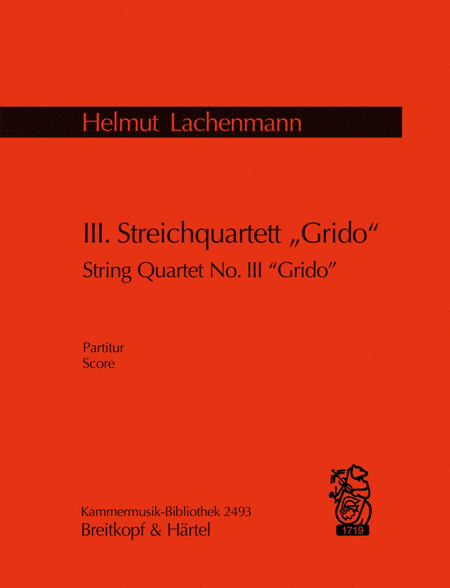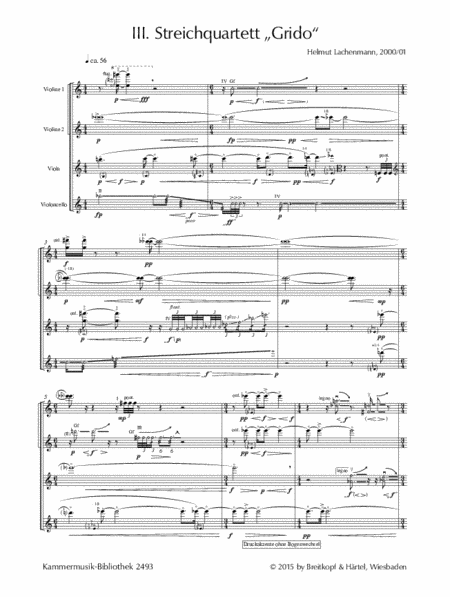String Quartet No. 3 "Grido"
score
-
Ships in 3 to 4 weeks
Details
Description
SKU: BR.KM-2493
Score. Composed by Helmut Lachenmann. Chamber music; Softbound. Kammermusik-Bibliothek (Chamber Music Library).World premiere: Melbourne, November 2, 2001The 2004 Royal Philharmonic Society Awards-winner for Chamber-scale Composition
Music post-1945; New music (post-2000). Full score (only). Composed 2001. 76 pages. Duration 28'. Breitkopf and Haertel #KM 2493. Published by Breitkopf and Haertel (BR.KM-2493).ISBN 9790004502990. 9 x 12 inches.
For me, composing means, if not "solving a problem", then indeed ecstatically grappling with a traumatic dilemma: to confront the technical challenges of composition - perceived and adopted - so as to bring about a resolution. While this situation, per se, is not new to me, it nonetheless remains alien, for it is in this that I lose myself, and in so doing truly find myself again. I know that sounds enigmatic, yet in different ways, every "problem", every "traumatic dilemma", embodies the categorical question of the possibility of authentic music. This concept of authenticity has become questionable because of mucics ubiquity and ready availability; administered on a global scale in a civilisation which has been flooded and saturated by music (auditory consumerist magic) and which, because it has become standardised, has been dulled. That questionability is an unconsciously recognisable and suppressed collective reality. It is the exterior of our repressible - yet no less real - inner longing for liberated space for the perceptive soul: for "new" music.My third String Quartet reacts to this situation under even more difficult circumstances. With the two preceding works for the same instrumental combination, I faced the game of coming to grips, each time with a different background of experience and certainly with different inner preconditions. The "Gran Torso" (1972) and the "Reigen Seliger Geister" [Roundelay of Blessed Souls] (1989) marked turning points in my compositional practice. In "Gran Torso", I exemplified one of my fundamental concepts which, rather than orientating itself on the principles of interval-rhythm-timbre, proceeded instead on the basis of turning concrete energy into sound production: a concept which I once provisionally labeled "musique concrete instrumentale". From the string quartet, I effectively made a 16-stringed instrumental body which reacted to maltreatment with its corporeality - sounding, rustling, breathing, pressing. As such, the traditional method of playing represented merely a specific variation of the overall possibilities with the instrument. Eighteen years later, my Second Quartet, the "Roundelay", could only exceed these boundaries by focusing on a single, developed playing technique: the "pressureless flautando", in which notes function more like shadows of sound (and vice versa - sound, or rather, pitchless murmurs, as shadows of intervallically precise, controlled notes and sequences). It was a focusing - that is, a refining and manifold modification - which, for its part, transformed diametrically opposed countersubjects. Using abruptly crescendoing bowing passages, which virtually sounded like recordings played backwards, in pizzicato soundscapes, a different or differently clattering world of sound and expression actually appeared. With both of these works I thought I had overcome the "trauma" associated with the string quartet, since I had almost reached the exact, middle path between the two works; namely, my Tanzsuite Mit Deutschlandlied (Dance Suite with Song of Germany) (1980) - a kind of concerto for string quartet and orchestra, in which I had already worked effectively with this instrumental combination.And now? What does Robinson Crusoe do if he believes his island to be developed? Does he settle down anew, returning in a self-established ambience to the lifestyle of bourgeois contentment? Should he heroically tear down the establishment again? Should he leave his nest? For he who seeks the way, what is one to do once the path through the impassable has been trodden? He reveals himself and writes his 3rd String Quartet, because the appearance of self-satisfaction is deceptive. Pathways in art don't lead anywhere and most certainly not to a destination. For this goal is nowhere else but here - where friction between the creative will and its processes turns the familiar into the foreign - and we are blind and deaf.Grido, Shout of Cryin Italian, is a personal dedication to the present members of the Arditti Quartet (Graeme, Rohan, Irvine, DOv). It also satisfies a request from Irvine Arditti for me to write a louder piece than my two previous quartets.(Helmut Lachenmann / program, Melbourne 2001)CDs: Arditti String QuartetCD Wittener Tage fur neue Kammermusik 2002Arditti String QuartetCD KAIROS, 0012662KAIstadler quartettCD NEOS 10806The JACK QuartetCD mode 267Stadler Quartett, Rg. Caroline SiegersDVD NEOS 51001 (2016)Bibliography:Alberman, David: Abnormal Playing Techniques in the String Quartets of Helmut Lachenmann, in: Helmut Lachenmann Music with matches, hrsg. von Dan Albertson, Contemporary Music Review 24 (2005), Vol. 1, pp. 39-51.Cavalotti, Pietro: Diagramme und Operative Bildlichkeit im Kompositionsprozess Helmut Lachenmanns, in: Helmut Lachenmann: Musik mit Bildern? Hrsg. von Matteo Nanni und Matthias Schmidt (= eikones, hrsg. von Nationalen Forschungsschwerpunkt Bildkritik an der Universitat Basel), Munchen: Wilhelm Fink 2012, pp. 117-139.Dulaney, Maxwell: Continuing the Tradition Untraditionally: Helmut Lachenmann's Restructuring of Musical Dialectic through an Analysis of his Three String Quartets, and an Original Composition, Harmonic Concerto, Diss. Brandeis University, MI 2013.Egger, Elisabeth: Kontinuitat, Verdichtung, Synchronizitat. Zu den grossformalen Funktionen des gepressten Bogenstrichs in Helmut Lachenmanns Streichquartetten, in: Musik als Wahrnehmungskunst. Untersuchungen zu Kompositionsmethodik und Horasthetik bei Helmut Lachenmann, hrsg. von Christian Utz und Clemens Gadenstatter (= musik.theorien der gegenwart 2), Saarbrucken: Pfau 2008, pp. 155-171.Hiekel, Jorn Peter: Die Streichquartett Gran Torso und Grido von Helmut Lachenmann, in: Lucerne Festival, Sommer 2005 Neuland, Konzertprogramm 6, pp. 65-69.Huppe, Eberhard: das bewegte streichquartett. Von Grido zu Double (Grido II), in: Neue Zeitschrift fur Musik 167 (2006), Heft 2, pp. 44-47.Jahn-Bossert, Hans-Peter: Fear of ? Essayistic Miniatures on Grido, in: Helmut Lachenmann Music with matches, hrsg. von Dan Albertson, Contemporary Music Review 24 (2005), Vol. 1, pp. 31-38.ders.: Schone Stellen. Verwundungen in Lachenmanns jungsten Werken, in: Musik inszeniert. Prasentation und Vermittlung zeitgenossischer Musik heute, hrsg. von Jorn Peter Hiekel (= Veroffentlichungen des Instituts fur Neue Musik und Musikerziehung Darmstadt, Band 46), Mainz u. a.: Schott 2006, pp. 59-72.Kuhn, Hans Niklas: Helmut Lachenmann. Grido und Double, in: Lucerne Festival, Sommer 2005 Neuland, Konzertprogramm 7, pp. 36-41.Mosch, Ulrich: Kunst als Medium der Ungeborgenheit. Streichquartette und soziale Funktion des Komponierens bei Helmut Lachenmann, in: Positionen 81 (November 2009), pp. 37-39.
World premiere: Melbourne, November 2, 2001The 2004 Royal Philharmonic Society Awards-winner for Chamber-scale Composition.


 Share
Share